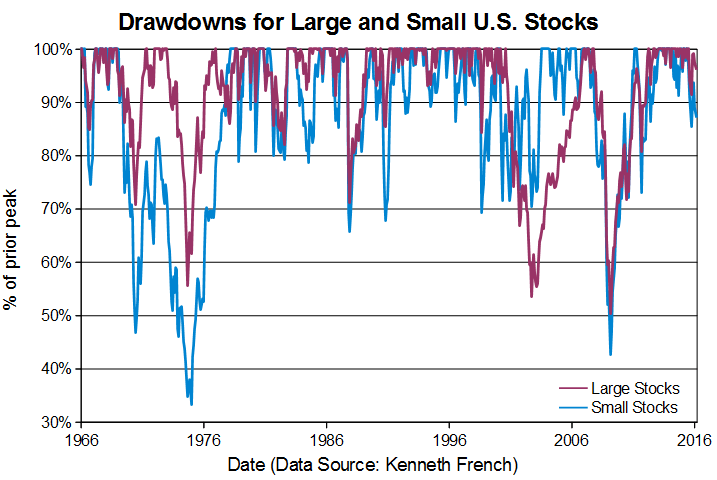Small cap stocks: How are they faring?
A history of small cap performance plus Norm Rothery's top Safer Canadian Dog picks
Advertisement
A history of small cap performance plus Norm Rothery's top Safer Canadian Dog picks
 You’ll immediately notice that stocks rarely make new highs and instead spend most of their time below them. (Nonetheless, the market has done very well over the long-term.)
It is also obvious that small stocks tend to suffer more than large stocks during downturns. (The Internet bubble was an exception.) Declines of 20% are relatively common for small stocks and they have fallen to about 40% of their former highs on a couple of occasions since the 1960s.
For stock market horror you have to go back to the crash of 1929 when small stocks tumbled to 9% of their former highs, including reinvested dividends. Gulp! Mind you, investors who held on profited handsomely over the years.
Those who are willing to take a walk on the wild side should pick up a copy of next month’s magazine to learn about the new crop of top small stocks.
You’ll immediately notice that stocks rarely make new highs and instead spend most of their time below them. (Nonetheless, the market has done very well over the long-term.)
It is also obvious that small stocks tend to suffer more than large stocks during downturns. (The Internet bubble was an exception.) Declines of 20% are relatively common for small stocks and they have fallen to about 40% of their former highs on a couple of occasions since the 1960s.
For stock market horror you have to go back to the crash of 1929 when small stocks tumbled to 9% of their former highs, including reinvested dividends. Gulp! Mind you, investors who held on profited handsomely over the years.
Those who are willing to take a walk on the wild side should pick up a copy of next month’s magazine to learn about the new crop of top small stocks.
| Name | Price | P/B | P/E | Earnings Yield | Dividend Yield |
|---|---|---|---|---|---|
| National Bank (NA) | $38.32 | 1.36 | 9.42 | 10.62% | 5.64% |
| CIBC (CM) | $89.88 | 1.75 | 10.12 | 9.88% | 5.12% |
| Bank of Nova Scotia (BNS) | $55.48 | 1.36 | 9.72 | 10.29% | 5.05% |
| Shaw (SJR.B) | $23.64 | 2.14 | 13.43 | 7.45% | 5.01% |
| BCE (BCE) | $58.38 | 3.88 | 19.59 | 5.10% | 4.68% |
| Bank of Montreal (BMO) | $73.87 | 1.31 | 11.01 | 9.08% | 4.55% |
| Royal Bank (RY) | $70.70 | 1.79 | 10.49 | 9.53% | 4.47% |
| TELUS (T) | $39.58 | 3.07 | 17.28 | 5.79% | 4.45% |
| Power (POW) | $28.93 | 1.07 | 7.25 | 13.79% | 4.30% |
| Agrium (AGU) | $113.34 | 1.88 | 12.92 | 7.74% | 4.26% |
Share this article Share on Facebook Share on Twitter Share on Linkedin Share on Reddit Share on Email